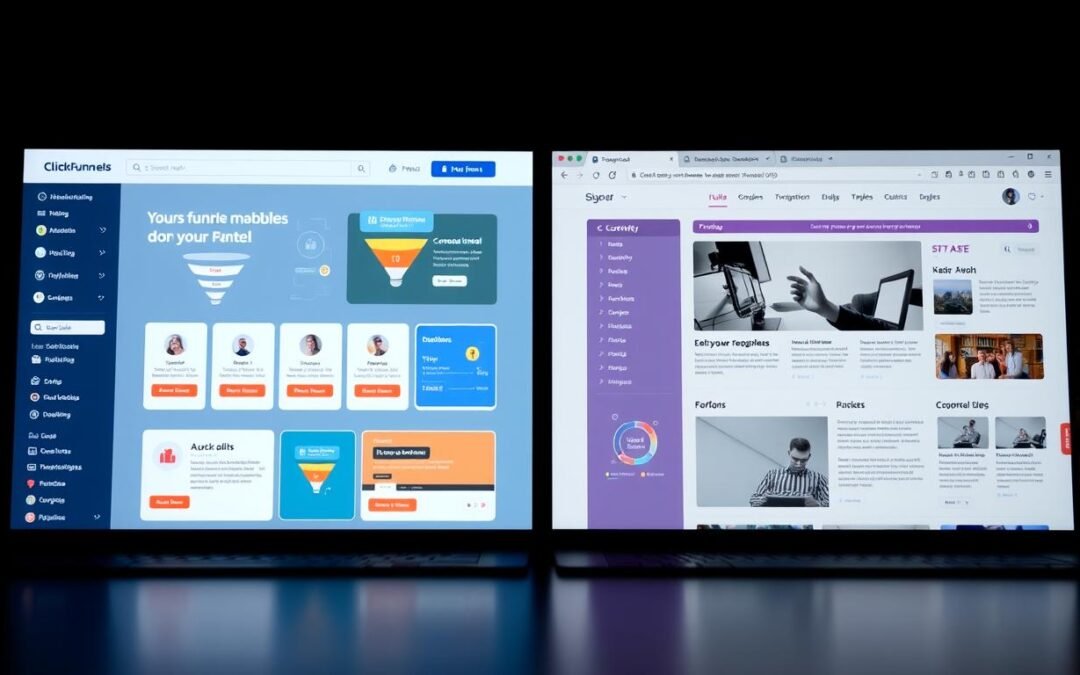In today’s digital world, businesses face a big choice. They must decide between using ClickFunnels or building a traditional website. Each option has its own benefits and drawbacks that affect business outcomes, customer interaction, and marketing plans.
This article will explore the differences between ClickFunnels and traditional websites. We’ll look at how they impact online sales and digital marketing. By understanding these differences, business owners can choose the best platform for their specific needs.
Introduction to Online Business Tools
Online business tools are key for today’s businesses to work better. They help with making websites, landing pages, and sales funnels. These digital marketing tools make things easier and help with talking to customers.
Using online tools well can really help a business grow. For example, WordPress is used by over 40% of websites. It shows how important strong platforms are for businesses. Tools like ClickFunnels help over 100,000 entrepreneurs, showing how vital online tools are for reaching out to customers.
These tools keep up with how people shop and act online. Businesses that change with these trends stay ahead. By using different digital marketing tools, companies can make their customers happier and sell more.
| Online Tool | Primary Function | Target Users | Key Features |
|---|---|---|---|
| WordPress | Website creation | Businesses of all sizes | User-friendly interface, extensive plugins |
| ClickFunnels | Sales funnels | Marketers, entrepreneurs | Drag-and-drop editor, optimized landing pages |
| WooCommerce | E-commerce | Online retailers | Shopping cart, inventory management |
| Wix | Website builder | Small businesses and individuals | Templates, blogging, design intelligence |
The Importance of Having an Online Presence
In today’s market, having a strong online presence is key. With over 1.5 billion websites, grabbing the right audience’s attention is tough. A good online presence boosts your visibility, helps build your brand, and engages customers.
Businesses that focus on their online visibility can build strong connections with customers. By sharing valuable content on a well-designed website, you educate and engage your audience. This approach also helps in Search Engine Optimization, bringing more organic traffic and boosting sales.
Many businesses struggle to stand out online. Without the right tools, they miss out on growth opportunities. A solid digital strategy can enhance your brand, increase customer interaction, and drive sales.
Why Do Businesses Need a Website?
A website is key for businesses. It helps with eCommerce, sharing info, and blogging. It lets companies show off products, share news, and talk to customers all in one place. This makes it easier to connect with customers and build a strong online image.
Versatility of Websites
Websites meet many needs for businesses. They help with:
- eCommerce to make buying easy.
- Sharing information about products and services.
- Creating blogs to attract more visitors.
This flexibility helps businesses connect with customers and show off their brand.
Difficulties in Managing and Tracking
But, managing a website can be tough. Owners struggle with web development. They face tasks like:
- Getting a domain name and hosting fees.
- Keeping the site updated and tracking analytics.
- Figuring out what customers like through metrics.
These problems can be too much for those without tech skills. Without a plan, businesses might lose customers instead of selling to them. Finding ways to overcome these issues is essential for online success.
What is ClickFunnels?
ClickFunnels is a powerful tool for online marketing. It uses a sales funnel to guide customers through steps to buy. Unlike regular websites, it focuses on getting people to take action.
By using a sales funnel, businesses can boost their sales and get more leads. This is because it’s designed to lead visitors to buy.
Overview of Sales Funnel Concepts
The sales funnel is a step-by-step guide for visitors. It aims to get them to buy a product or service. Each step builds on the last, making it easier to sell.
This method helps by removing distractions. It keeps the focus on making a sale.
Key Features of ClickFunnels
ClickFunnels makes creating sales funnels easy. It has a drag-and-drop editor for designing funnels without coding. It also has a library of templates for different business types.
It has tools for email marketing and analytics. These help track business performance. It also has features for team work, making it easier to collaborate remotely.
ClickFunnels stands out by having many tools in one place. It includes CRM, membership site builder, and eCommerce features. This makes it easy to manage marketing efforts and save money.
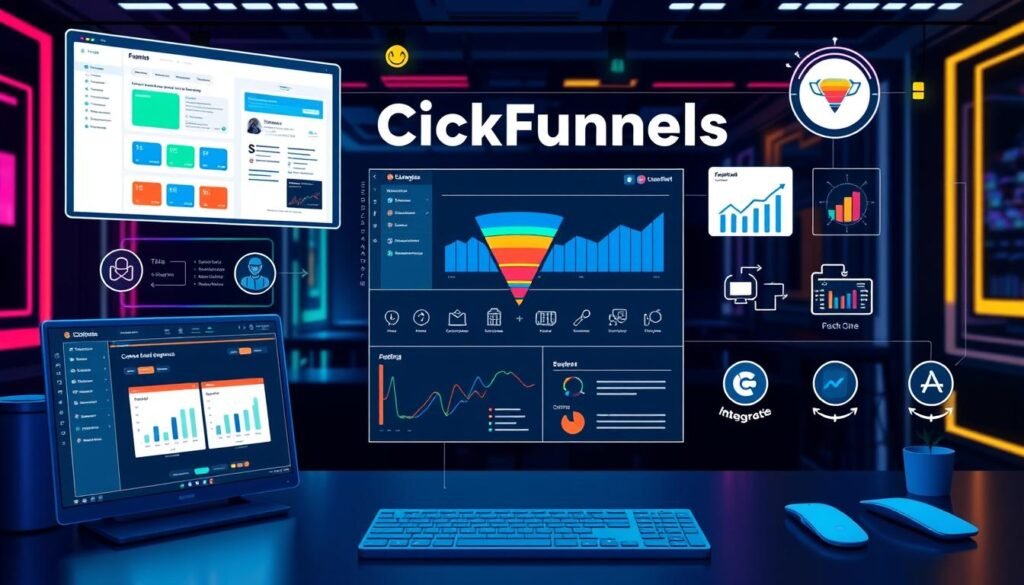
| ClickFunnels Features | Description |
|---|---|
| Drag-and-Drop Editor | Easy-to-use interface for creating sales funnels without coding skills. |
| High-Converting Templates | A library of pre-built funnel templates designed for various business needs. |
| Automation Tools | Streamlined email marketing and customer engagement features. |
| CRM Integration | Management of sales pipelines within ClickFunnels, eliminating the need for separate CRM software. |
| Team Collaboration | Features for remote teams to work together effectively on funnel creation. |
Benefits of Using ClickFunnels
ClickFunnels offers many benefits to make marketing easier for businesses. It has a simple design that’s easy to use. This means you don’t need to know a lot about tech to use it.
This lets business owners focus on their marketing plans. They don’t have to worry about setting up websites the hard way.
Easy to Use Interface
ClickFunnels is great for entrepreneurs because it’s easy to use. Its design makes creating and managing sales funnels simple. This saves a lot of time.
It’s perfect for those who want to start marketing fast. You don’t need to spend hours learning how to use it.
Pre-built Templates for Quick Setup
ClickFunnels has lots of customizable templates. These are made for different industries. They make setting up sales funnels fast and easy.
With these templates, your sales funnels will look professional right away. This saves time and lets you focus on making sales.
Improved Customer Retention Techniques
ClickFunnels helps keep customers coming back. It has tools for marketing that keep customers engaged. This includes email follow-ups that are tailored to different groups.
This helps build loyalty. It encourages customers to buy more and stay with your business for a long time.
| Feature | Description | Benefits |
|---|---|---|
| User-Friendly Interface | Intuitive design allowing easy navigation | Reduces time spent on setup |
| Customizable Templates | Pre-built, conversion-optimized designs | Quick setup for various industries |
| Customer Retention Strategies | Automated email follow-ups and nurturing | Increases customer loyalty and repeat sales |
Understanding Sales Funnels
A sales funnel is a path that leads people from awareness to buying. It has different stages, each needing its own strategy to keep leads interested. Knowing these stages is key for businesses to boost their marketing and sales.
The funnel has phases like awareness, interest, consideration, and action. By guiding people through these, businesses can offer a personalized experience. This makes it more likely for people to buy. ClickFunnels helps by making it easy to create effective sales funnels.
Sales funnels are much better at converting than regular websites, by 137%. They focus on building trust with customers, which can increase what customers spend. The Value Ladder idea shows how to start with low-cost offers and move to more expensive ones.
Many entrepreneurs have made a lot of money using ClickFunnels. Some funnels have even made over $1 million in a year. This shows how well sales funnels work in turning leads into sales and making more money than websites.
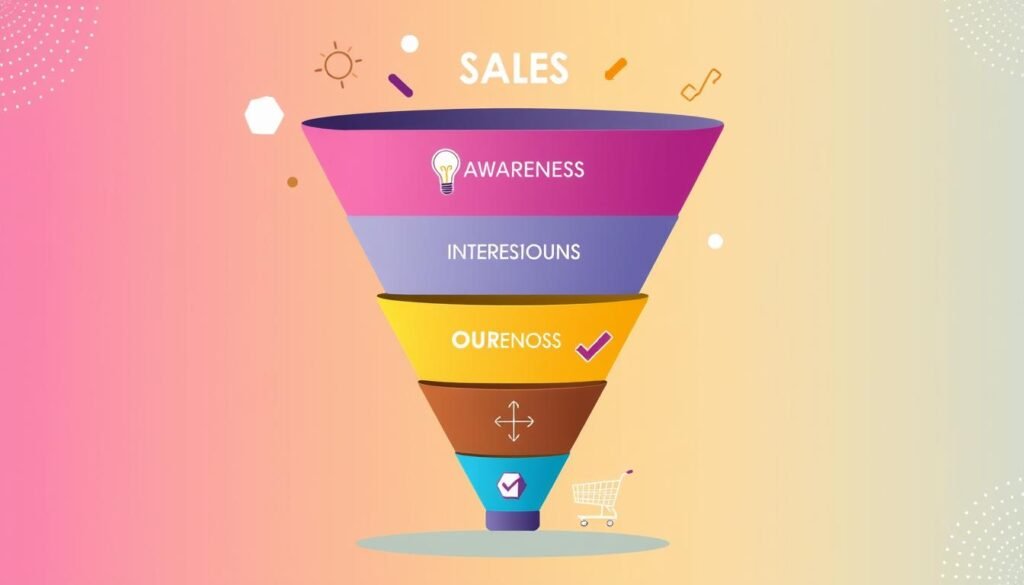
| Sales Funnel Stage | Objective | Key Strategy |
|---|---|---|
| Awareness | Attract possible customers | Content marketing, social media outreach |
| Interest | Keep leads engaged | Give valuable info, lead magnets |
| Consideration | Build relationships | Email campaigns, personalized follow-ups |
| Action | Get people to buy | Strong calls-to-action, limited-time offers |
Using a dynamic sales funnel makes the customer journey better and boosts sales. It’s a vital tool for businesses today. These strategies help businesses succeed in a tough online world.
ClickFunnels vs Website: A Comparative Look
Choosing between ClickFunnels and a traditional website depends on several factors. These include functionality and what you aim to achieve. Both options have their advantages and drawbacks. This comparison aims to help you make a well-informed decision.
Pros and Cons of ClickFunnels
ClickFunnels excels in certain areas, showing several benefits:
- User-friendly Interface: Its drag-and-drop editor makes creating sales funnels easy.
- Pre-designed Templates: These templates help speed up setting up different types of funnels.
- Marketing Features: It has great tools for A/B testing, email integrations, and analytics to boost conversion rates.
- E-commerce Capabilities: It has built-in features for creating checkout pages, making online sales smoother.
Yet, some drawbacks of ClickFunnels are:
- Customization Limitations: Users wanting more design flexibility might find it restrictive.
- Cost Structure: Monthly fees can add up as businesses grow and need more features.
Pros and Cons of Traditional Websites
Traditional websites also have their own set of benefits and drawbacks:
- Extensive Customization: Platforms like WordPress offer almost unlimited customization options through thousands of plugins.
- SEO Advantages: Tools like Yoast SEO can significantly improve website rankings.
- Economic Scalability: WordPress can grow more economically with various pricing options for hosting and development.
But, there are also challenges with traditional websites:
- Learning Curve: Setting up can require technical knowledge, making it less accessible for some.
- Management Difficulties: Tracking conversions and maintaining performance can be more complex than with ClickFunnels.
| Feature | ClickFunnels | Traditional Websites |
|---|---|---|
| Ease of Use | User-friendly drag-and-drop editor | Varied, often requires technical knowledge |
| Customization | Limited customization options | Extensive customization through plugins |
| SEO Tools | Basic SEO options | Advanced SEO through plugins like Yoast |
| Cost | Starts at $127/month | Free with possible hosting and plugin costs |
| Target Users | Ideal for marketers and e-commerce | Great for bloggers and businesses seeking control |
The Learning Curve: ClickFunnels vs Traditional Websites
When looking at online business tools, ClickFunnels is known for being easy to use. It’s great for those who aren’t tech-savvy, making it simple to set up sales funnels. Traditional websites, on the other hand, need more technical knowledge to start and keep up with.
ClickFunnels has two versions: Classic and 2.0. Classic has drag-and-drop editing and templates, making it easy to use. Version 2.0 adds more features like Smart Themes and predictive analytics, helping businesses grow.
Traditional websites can be customized and help with search engine optimization. But, they can be expensive, costing $200 to $6000 upfront and $50 to $500 a month. ClickFunnels, starting at $97 a month, is more affordable for those looking for a simpler option.
Comparing these tools shows ClickFunnels’ big advantage. It has a lower learning curve and easier processes. This lets users focus on getting more leads and making sales.
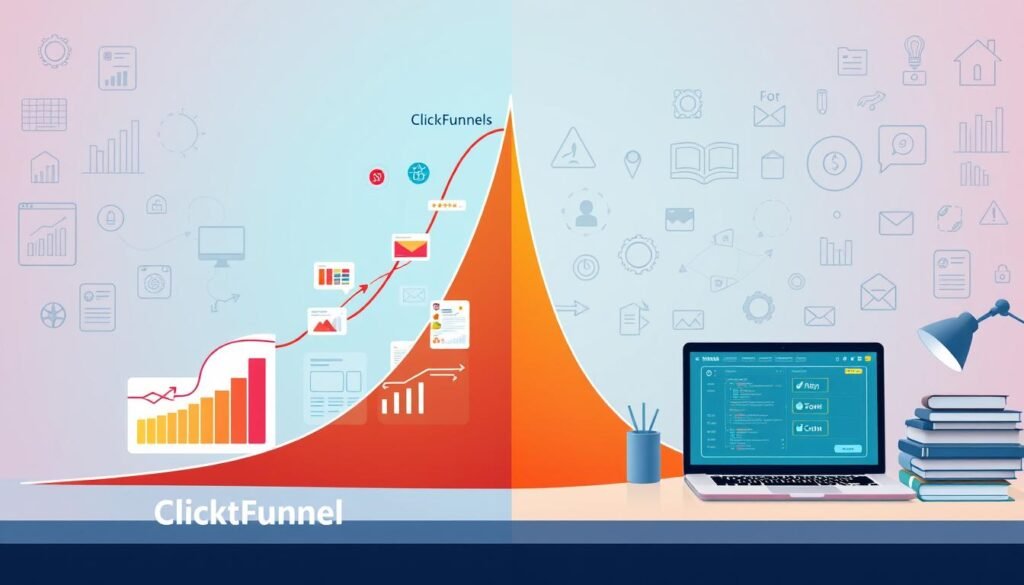
Cost Comparison: ClickFunnels vs Website
Choosing between ClickFunnels and a traditional website depends on understanding cost comparison. Both have their own prices and benefits. ClickFunnels starts at $147 a month, which is a lot for sales funnel tools. This is more than what you pay for hosting or domain names.
For example, SquareSpace starts at just $16 a month. This is great for new businesses.
Let’s look at the costs:
| Feature | Cost (ClickFunnels) | Cost (Traditional Website) |
|---|---|---|
| Basic Subscription | $147/month | $16/month (SquareSpace) |
| Course Creator | $150/month | N/A |
| CRM Functions | $200/month | N/A |
| Email Marketing Tools | $120/month | $10/month (Mailchimp average) |
| Transaction Fees | 0% | 0-3% |
| Discount Offers | Total of $240-$3,468/year | Up to 25% off/year |
ClickFunnels might seem expensive at first. But it has lots of tools for making sales better. It can save you money in the long run by making marketing more efficient.
When to Choose ClickFunnels Over a Traditional Website
Choosing between ClickFunnels and a traditional website can greatly affect your business. Each option has its own benefits, depending on what you want to achieve. Knowing when to use ClickFunnels can improve customer satisfaction and increase sales.
For E-commerce Businesses
ClickFunnels provides specialized eCommerce solutions that make online shopping better. It focuses on sales funnels for eCommerce, making buying easier. This leads to more sales than traditional websites.
Traditional websites need lots of content and complex navigation. ClickFunnels is easy to change and use, thanks to its templates. This means businesses can start selling online quickly.
For Lead Generation Campaigns
ClickFunnels is great for getting leads. It tracks user actions and lets you tweak your strategy as you go. This way, you can turn more visitors into valuable contacts.
ClickFunnels makes testing different approaches easy. It also has built-in email marketing tools. These features help businesses get more leads than traditional websites can.
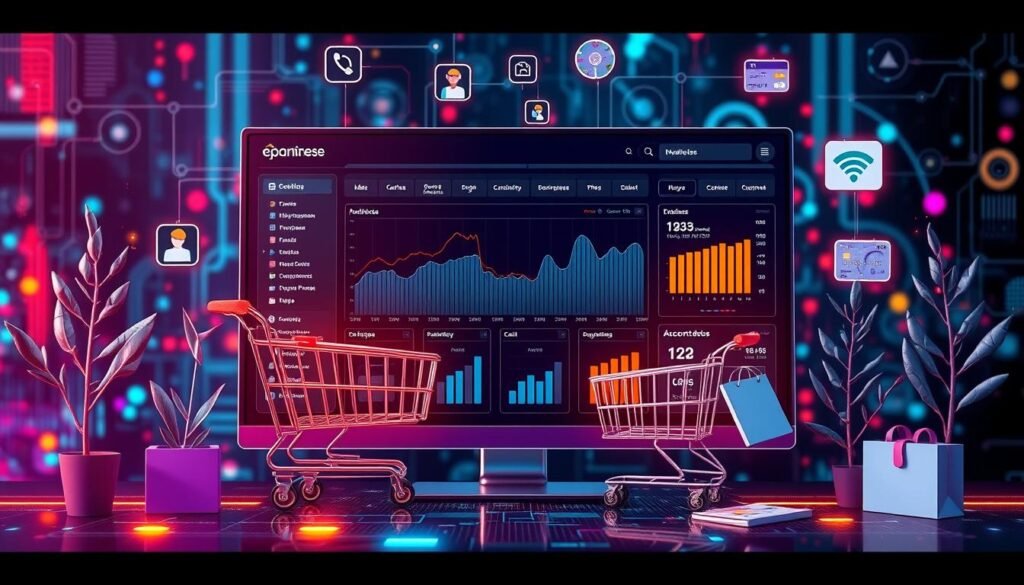
| Feature | ClickFunnels | Traditional Websites |
|---|---|---|
| Focus on Conversion | Highly optimized for sales funnels | General information pages |
| Lead Capture | Automated and targeted | Manual forms and lesser tracking |
| Ease of Use | Intuitive funnel creation | Complex setups and changes |
| Template Availability | Ready-to-use templates | Requires custom design work |
| Support | 24/7 support and knowledge base | Varies by developer |
The Role of Customization in Online Tools
Customization options greatly impact a business’s online presence. They help engage the target audience better. Traditional websites, like those on WordPress, offer many customization options. These include themes, plugins, and editing the source code.
This flexibility lets users create personalized websites. These sites reflect the brand’s identity and meet specific customer needs.
ClickFunnels, on the other hand, makes creating marketing funnels easy but has fewer customization options. It helps businesses design marketing strategies but lacks the wide marketing flexibility of a full website. While it’s easy to use, it might limit personalization in online visibility.
The choice between WordPress and ClickFunnels depends on what a business needs. ClickFunnels is great for a dedicated sales funnel. But for a customizable, all-in-one web experience, WordPress is better. Knowing the strengths of each tool helps businesses use their online presence effectively.
| Feature | WordPress | ClickFunnels |
|---|---|---|
| Customization Options | Extensive with themes, plugins, and code editing | Limited to funnel-related elements |
| Marketing Flexibility | High, suitable for various business types | Primarily focused on sales funnels |
| Ease of Use | Requires some technical knowledge | User-friendly for non-technical users |
| Analytics and Reporting | Basic through plugins | Advanced features built-in |
| Community Support | Global community with extensive resources | Dedicated support channels and user community |
Integration with Other Platforms
ClickFunnels works well with other platforms to boost online sales. Businesses can use different tools’ strengths to make a strong strategy. This strategy combines great sales funnels with strong content and eCommerce platforms.
WordPress and ClickFunnels Integration
The ClickFunnels WordPress integration makes websites better. It lets users add ClickFunnels pages to their WordPress sites. This keeps the brand look and helps increase sales.
The WordPress ClickFunnels Plugin makes it easy to use. It lets users manage content on WordPress while using funnel features.
Using ClickFunnels with Shopify
ClickFunnels and Shopify together are a big win for business. The Shopify ClickFunnels integration lets users handle products and sales in one place. This makes work easier.
By using ClickFunnels with Shopify, businesses can sell more and improve customer experience. This partnership is a strong solution for online sellers to grow their sales.
Building a Brand Image: Which Option Works Better?
Choosing between ClickFunnels and traditional websites is key for brand image. ClickFunnels is great for creating focused marketing funnels. It helps turn leads into customers with its easy-to-use design and stages.
Traditional websites, on the other hand, offer more flexibility in content. They help businesses show their brand through different media. Yet, they might struggle to get traffic and engage visitors.
Using ClickFunnels with a website can boost traffic and performance. It lets you create targeted landing pages that increase conversions. Businesses see better online branding and more meaningful customer interactions with ClickFunnels.
| Feature | ClickFunnels | Traditional Websites |
|---|---|---|
| Price | Starting at $99/month after a 14-day free trial | Free or varies based on hosting and design tools |
| User-Friendliness | More user-friendly; quick setup | Can have a steep learning curve depending on the platform |
| Customization | Pre-built funnel templates, email marketing automation | High-level design flexibility and variety of functionalities |
| Purpose | Focused on sales and conversions | Variety of purposes including information, branding, and e-commerce |
| Integration | Integrates well with various marketing tools and platforms | Flexible integrations depending on the chosen website builder |
Both ClickFunnels and traditional websites are important for a strong brand image. The right choice depends on your business goals and what you want to achieve in customer perception and online branding.
Real-Life Success Stories with ClickFunnels
ClickFunnels has changed the marketing game for many businesses. It’s a key tool for boosting lead generation and conversion rates. Countless success stories show its power as a marketing tool.
Companies of all sizes use ClickFunnels to make sales funnels that increase revenue. It’s easy to use, helping over 27,000 users share their success stories and business testimonials. These ClickFunnels case studies show how entrepreneurs have grown their businesses.
Many online marketers have seen big revenue jumps thanks to ClickFunnels. They’ve sold to over 5 million customers. The platform has helped create 973,422 sales funnels, sharing valuable insights.
- Increased conversion rates across various industries.
- Streamlined marketing processes, allowing for efficiency.
- Customizable funnels that cater to specific business needs.
Success stories with ClickFunnels keep coming. Users have made over 3.7 million pages, showing off their creativity. ClickFunnels is a key to growing a business, unlike traditional websites.
In short, real-life case studies prove ClickFunnels is essential for businesses online. The testimonials inspire others to join the ClickFunnels community, showing the path to success.
Conclusion
When businesses look at online solutions like ClickFunnels and traditional websites, the choice depends on their needs. ClickFunnels, launched in 2014, makes building sales funnels easy. It’s great for companies focusing on getting more leads and sales.
Its easy-to-use design and wide range of features help businesses grow fast online. On the other hand, WordPress is a big player, powering over 43.2% of all websites. It offers flexibility, scalability, and customization, making it a top choice for many.
While ClickFunnels costs around $127 to $208 a month, WordPress is more affordable at the start. This makes WordPress a good option for smaller businesses. It offers many ways to meet different business goals without breaking the bank.
In the end, knowing the differences between ClickFunnels and websites helps business owners make better choices. The key takeaway is to pick tools that fit your business strategy for success online.
FAQ
What is the main difference between ClickFunnels and a traditional website?
Are ClickFunnels users able to customize their sales funnels?
Can ClickFunnels be integrated with other platforms?
What types of businesses benefit most from using ClickFunnels?
Is it easier to learn how to use ClickFunnels compared to traditional website builders?
What are some advantages of using ClickFunnels for digital marketing?
How do ClickFunnels and traditional websites impact customer engagement?
What costs are associated with establishing a traditional website compared to ClickFunnels?
Source Links
- https://imnights.com/dropfunnels-vs-clickfunnels/
- https://www.utilizeyourbusiness.com/clickfunnels-vs-website/
- https://flyrise.io/clickfunnels-vs-wordpress/
- https://imnights.com/clickfunnels-vs-wix/
- https://www.matellio.com/blog/reasons-why-clickfunnels-are-better-than-a-traditional-website/
- https://smesitebuilder.com/blog/website-vs-click-funnels-do-you-need-both
- https://blackswanmedia.co/clickfunnels-vs-website/
- https://imnights.com/do-i-need-a-website-for-clickfunnels/
- https://www.clickfunnels.com/blog/clickfunnels-vs-website-build-website-for-your-business/
- https://www.clickfunnels.com/blog/clickfunnels-2-0-vs-webs/
- https://www.freedomboundbusiness.com/clickfunnels-vs-website/
- https://www.clickfunnels.com/blog/benefits-of-clickfunnels/
- https://www.clearvoice.com/resources/click-funnels-how-to-use-them/
- https://www.clickfunnels.com/blog/clickfunnels-vs-website/
- https://www.clickfunnels.com/blog/sales-funnel-vs-website/
- https://hustlelife.net/clickfunnels-vs-website/
- https://passionates.com/clickfunnels-vs-wordpress-an-in-depth-comparison/
- https://imnights.com/clickfunnels-vs-simvoly/
- https://analytive.com/blog/comparing-clickfunnels-classic-vs-2-0-which-is-right-for-you/
- https://revolist.sg/clickfunnels-vs-website/
- https://www.clickfunnels.com/blog/clickfunnels-2-0-against-the-world/
- https://supplygem.com/compare/clickfunnels-vs-squarespace/
- https://www.elegantthemes.com/blog/wordpress/wordpress-vs-clickfunnels
- https://seosorcerer.com/clickfunnels-vs-wordpress/
- https://wpbrigade.com/clickfunnels-vs-wordpress/
- https://cmsminds.com/blog/clickfunnels-wordpress-integration/
- https://www.getmagical.com/blog/clickfunnels-integrations
- https://www.archcowebdesign.com/blog/webflow-clickfunnels-website
- https://khrisdigital.com/can-clickfunnels-replace-your-website/
- https://analytive.com/blog/clickfunnels-vs-wix-a-comprehensive-comparison/
- https://marketingsecrets.com/blog/304-writing-the-clickfunnels-startup-story
- https://www.clickfunnels.com/blog/clickfunnels-changing-lives-one-funnel-time/
- https://wcanvas.com/blog/clickfunnels-vs-wordpress-which-is-better-in-2024/
- https://leadsync.me/blog/clickfunnels-review/
- https://www.cleverence.com/articles/shopify/shopify-vs-clickfunnels-comparing-e-commerce-platforms/

